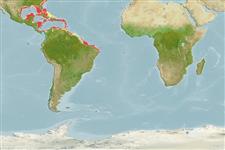Common names from other countries
>
Eupercaria/misc (Various families in series Eupercaria) >
Malacanthidae (Tilefishes)
Etymology: Malacanthus: Greek, mala = a lot + Greek, akantha = thorn (Ref. 45335).
More on author: Bloch.
Environment: milieu / climate zone / depth range / distribution range
Ecología
marino asociado a arrecife; rango de profundidad 10 - 153 m (Ref. 9626), usually 10 - 50 m (Ref. 9626). Subtropical; 34°N - 8°S
Western Atlantic: North Carolina (USA), Gulf of Mexico, and throughout the Caribbean to Rio de la Plata, Uruguay. Southeast Atlantic: Ascension Island.
Tamaño / Peso / Age
Maturity: Lm ? range ? - ? cm
Max length : 70.0 cm SL macho / no sexado; (Ref. 8991); common length : 50.0 cm TL macho / no sexado; (Ref. 3644); peso máximo publicado: 1.0 kg (Ref. 40637)
Short description
Claves de identificación | Morfología | Morfometría
Espinas dorsales (total) : 4 - 5; Radios blandos dorsales (total) : 53 - 57; Espinas anales: 1; Radios blandos anales: 50 - 52. Caudal fin lunate.
Primarily a shallow-water benthic species found on sand and rubble bottoms (Ref. 5246). Builds mounds of rubble and shell fragments near reefs and grass beds; enters its mound head first when frightened (Ref. 5246). Feeds mainly on stomatopods, fishes, polychaete worms, chitons, sea urchins, sea stars, amphipods and shrimps (Ref. 3644). Tends to bite when handled (Ref. 5246). Marketed fresh (Ref. 5246). Between 1995 and 2000, at least 7 specimens have been traded as aquarium fish at Ceará, Brazil (Ref. 49392).
Life cycle and mating behavior
Maturities | Reproducción | Spawnings | Egg(s) | Fecundities | Larva
Dooley, J.K., 1978. Systematics and biology of the tilefishes (Perciformes: Branchiostegidae and Malacanthidae) with descriptions of two new species. NOAA Tech. Rep. NMFS Circ. No. 411:1-78. (Ref. 8991)
IUCN Red List Status (Ref. 130435)
CITES (Ref. 128078)
Not Evaluated
Threat to humans
Traumatogenic (Ref. 5246)
Human uses
Pesquerías: escaso valor comercial
Herramientas
Special reports
Download XML
Fuentes de Internet
Estimates based on models
Preferred temperature (Ref.
115969): 23.6 - 28, mean 26.7 (based on 308 cells).
Phylogenetic diversity index (Ref.
82804): PD
50 = 0.6250 [Uniqueness, from 0.5 = low to 2.0 = high].
Bayesian length-weight: a=0.00537 (0.00236 - 0.01221), b=3.03 (2.82 - 3.24), in cm Total Length, based on LWR estimates for this (Sub)family-body shape (Ref.
93245).
Nivel trófico (Ref.
69278): 3.7 ±0.3 se; based on diet studies.
Fishing Vulnerability (Ref.
59153): Moderate to high vulnerability (54 of 100).
